Nigel S., Chambers S., Johnson R. Operations Management
Подождите немного. Документ загружается.


Part Three Planning and control
344
Figure 12.3 Cycle inventory in a bakery
products in batches, and the amount of it depends on volume decisions which are described
in a later section of this chapter.
De-coupling Inventory
Wherever an operation is designed to use a process layout (introduced in Chapter 7), the
transformed resources move intermittently between specialized areas or departments that
comprise similar operations. Each of these areas can be scheduled to work relatively inde-
pendently in order to maximize the local utilization and efficiency of the equipment and
staff. As a result, each batch of work-in-progress inventory joins a queue, awaiting its turn
in the schedule for the next processing stage. This also allows each operation to be set to
the optimum processing speed (cycle time), regardless of the speed of the steps before and
after. Thus de-coupling inventory creates the opportunity for independent scheduling and
processing speeds between process stages.
Anticipation inventory
In Chapter 11 we saw how anticipation inventory can be used to cope with seasonal demand.
Again, it was used to compensate for differences in the timing of supply and demand. Rather
than trying to make the product (such as chocolate) only when it was needed, it was pro-
duced throughout the year ahead of demand and put into inventory until it was needed.
Anticipation inventory is most commonly used when demand fluctuations are large but
relatively predictable. It might also be used when supply variations are significant, such as in
the canning or freezing of seasonal foods.
Pipeline inventory
Pipeline inventory exists because material cannot be transported instantaneously between
the point of supply and the point of demand. If a retail store orders a consignment of items
from one of its suppliers, the supplier will allocate the stock to the retail store in its own
warehouse, pack it, load it onto its truck, transport it to its destination, and unload it into
the retailer’s inventory. From the time that stock is allocated (and therefore it is unavail-
able to any other customer) to the time it becomes available for the retail store, it is pipeline
inventory. Pipeline inventory also exists within processes where the layout is geographically
spread out. For example, a large European manufacturer of specialized steel regularly moves
cargoes of part-finished materials between its two mills in the UK and Scandinavia using
a dedicated vessel that shuttles between the two countries every week. All the thousands of
tonnes of material in transit are pipeline inventory.
De-coupling inventory
Anticipation inventory
Pipeline inventory
M12_SLAC0460_06_SE_C12.QXD 10/20/09 9:45 Page 344

Chapter 12 Inventory planning and control
345
Some disadvantages of holding inventory
Although inventory plays an important role in many operations performance, there are a
number of negative aspects of inventory.
● Inventory ties up money, in the form of working capital, which is therefore unavailable for
other uses, such as reducing borrowings or making investment in productive fixed assets
(we shall expand on the idea of working capital later).
● Inventory incurs storage costs (leasing space, maintaining appropriate conditions, etc.).
● Inventory may become obsolete as alternatives become available.
● Inventory can be damaged, or deteriorate.
● Inventory could be lost, or be expensive to retrieve, as it gets hidden amongst other inventory.
● Inventory might be hazardous to store (for example flammable solvents, explosives,
chemicals and drugs), requiring special facilities and systems for safe handling.
● Inventory uses space that could be used to add value.
● Inventory involves administrative and insurance costs.
The position of inventory
Not only are there several reasons for supply–demand imbalance, there could also be several
points where such imbalance exists between different stages in the operation. Figure 12.4
illustrates different levels of complexity of inventory relationships within an operation.
Perhaps the simplest level is the single-stage inventory system, such as a retail store, which
will have only one stock of goods to manage. An automotive parts distribution operation
will have a central depot and various local distribution points which contain inventories. In
many manufacturers of standard items, there are three types of inventory. The raw material
and components inventories (sometimes called input inventories) receive goods from the
operation’s suppliers; the raw materials and components work their way through the various
stages of the production process but spend considerable amounts of time as work-in-progress
(or work-in-process) (WIP) before finally reaching the finished goods inventory.
A development of this last system is the multi-echelon inventory system. This maps
the relationship of inventories between the various operations within a supply network
(see Chapter 6). In Figure 12.4(d) there are five interconnected sets of inventory systems. The
second-tier supplier’s (yarn producer’s) inventories will feed the first-tier supplier’s (cloth
producer’s) inventories, who will in turn supply the main operation. The products are dis-
tributed to local warehouses from where they are shipped to the final customers. We will
discuss the behaviour and management of such multi-echelon systems in the next chapter.
Day-to-day inventory decisions
At each point in the inventory system, operations managers need to manage the day-to-day
tasks of running the system. Orders will be received from internal or external customers;
these will be dispatched and demand will gradually deplete the inventory. Orders will need
to be placed for replenishment of the stocks; deliveries will arrive and require storing. In
managing the system, operations managers are involved in three major types of decision:
● How much to order. Every time a replenishment order is placed, how big should it be
(sometimes called the volume decision)?
● When to order. At what point in time, or at what level of stock, should the replenishment
order be placed (sometimes called the timing decision)?
● How to control the system. What procedures and routines should be installed to help make
these decisions? Should different priorities be allocated to different stock items? How
should stock information be stored?
Raw materials inventory
Components inventory
Work-in-progress
Finished goods inventory
Multi-echelon inventory
M12_SLAC0460_06_SE_C12.QXD 10/20/09 9:45 Page 345
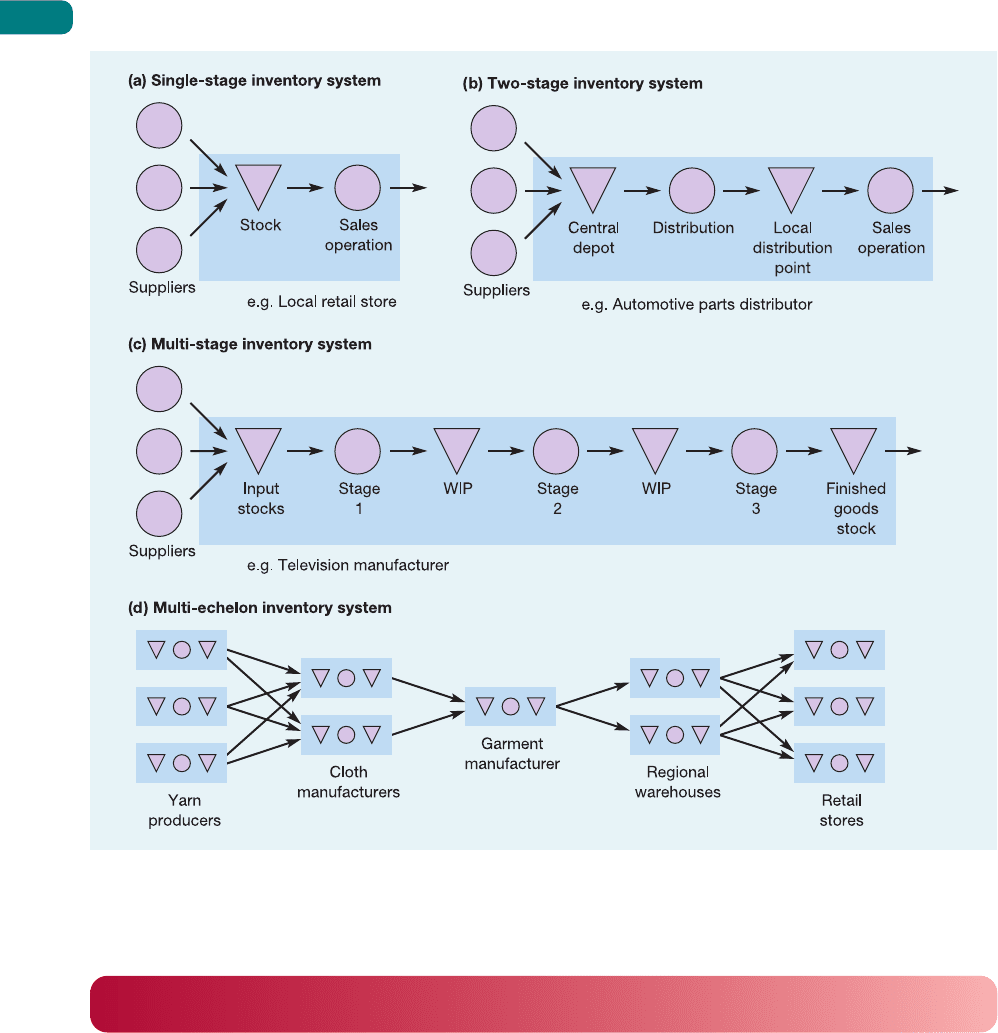
Part Three Planning and control
346
Figure 12.4 (a) Single-stage, (b) two-stage, (c) multi-stage and (d) multi-echelon inventory systems
The volume decision – how much to order
To illustrate this decision, consider again the example of the food and drinks we keep at
our home. In managing this inventory we implicitly make decisions on order quantity,
which is how much to purchase at one time. In making this decision we are balancing two
sets of costs: the costs associated with going out to purchase the food items and the costs
associated with holding the stocks. The option of holding very little or no inventory of food
and purchasing each item only when it is needed has the advantage that it requires little
money since purchases are made only when needed. However, it would involve purchas-
ing provisions several times a day, which is inconvenient. At the very opposite extreme,
making one journey to the local superstore every few months and purchasing all the provi-
sions we would need until our next visit reduces the time and costs incurred in making the
purchase but requires a very large amount of money each time the trip is made – money
M12_SLAC0460_06_SE_C12.QXD 10/20/09 9:45 Page 346

which could otherwise be in the bank and earning interest. We might also have to invest in
extra cupboard units and a very large freezer. Somewhere between these extremes there
will lie an ordering strategy which will minimize the total costs and effort involved in the
purchase of food.
Inventory costs
The same principles apply in commercial order-quantity decisions as in the domestic situation.
In making a decision on how much to purchase, operations managers must try to identify
the costs which will be affected by their decision. Several types of costs are directly associated
with order size.
1 Cost of placing the order. Every time that an order is placed to replenish stock, a number
of transactions are needed which incur costs to the company. These include the clerical
tasks of preparing the order and all the documentation associated with it, arranging for
the delivery to be made, arranging to pay the supplier for the delivery, and the general
costs of keeping all the information which allows us to do this. Also, if we are placing an
‘internal order’ on part of our own operation, there are still likely to be the same types
of transaction concerned with internal administration. In addition, there could also be
a ‘changeover’ cost incurred by the part of the operation which is to supply the items,
caused by the need to change from producing one type of item to another.
2 Price discount costs. In many industries suppliers offer discounts on the normal purchase
price for large quantities; alternatively they might impose extra costs for small orders.
3 Stock-out costs. If we misjudge the order-quantity decision and our inventory runs out
of stock, there will be costs to us incurred by failing to supply our customers. If the
customers are external, they may take their business elsewhere; if internal, stock-outs
could lead to idle time at the next process, inefficiencies and, eventually, again, dissatisfied
external customers.
4 Working capital costs. Soon after we receive a replenishment order, the supplier will demand
payment for their goods. Eventually, when (or after) we supply our own customers, we
in turn will receive payment. However, there will probably be a lag between paying our
suppliers and receiving payment from our customers. During this time we will have to
fund the costs of inventory. This is called the working capital of inventory. The costs
associated with it are the interest we pay the bank for borrowing it, or the opportunity
costs of not investing it elsewhere.
5 Storage costs. These are the costs associated with physically storing the goods. Renting,
heating and lighting the warehouse, as well as insuring the inventory, can be expensive,
especially when special conditions are required such as low temperature or high security.
6 Obsolescence costs. When we order large quantities, this usually results in stocked items
spending a long time stored in inventory. Then there is a risk that the items might either
become obsolete (in the case of a change in fashion, for example) or deteriorate with age
(in the case of most foodstuffs, for example).
7 Operating inefficiency costs. According to lean synchronization philosophies, high inventory
levels prevent us seeing the full extent of problems within the operation. This argument is
fully explored in Chapter 15.
There are two points to be made about this list of costs. The first is that some of the
costs will decrease as order size is increased; the first three costs are like this, whereas the
other costs generally increase as order size is increased. The second point is that it may not
be the same organization that incurs the costs. For example, sometimes suppliers agree to
hold consignment stock. This means that they deliver large quantities of inventory to their
customers to store but will only charge for the goods as and when they are used. In the mean-
time they remain the supplier’s property so do not have to be financed by the customer, who
does, however, provide storage facilities.
Consignment stock
Chapter 12 Inventory planning and control
347
M12_SLAC0460_06_SE_C12.QXD 10/20/09 9:45 Page 347
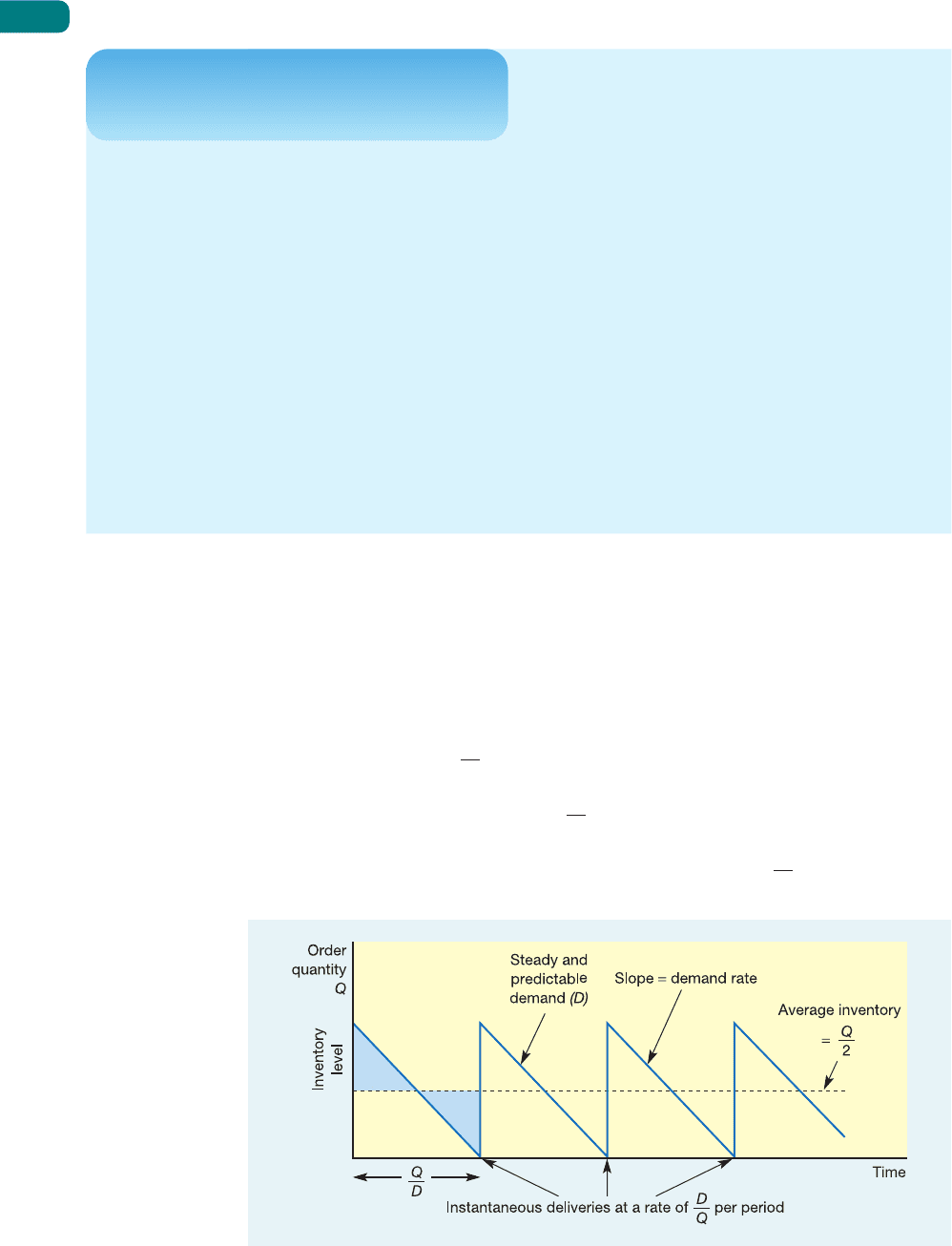
Inventory profiles
An inventory profile is a visual representation of the inventory level over time. Figure 12.5
shows a simplified inventory profile for one particular stock item in a retail operation. Every
time an order is placed, Q items are ordered. The replenishment order arrives in one batch
instantaneously. Demand for the item is then steady and perfectly predictable at a rate of
D units per month. When demand has depleted the stock of the items entirely, another order
of Q items instantaneously arrives, and so on. Under these circumstances:
The average inventory = (because the two shaded areas in Fig. 12.5 are equal)
The time interval between deliveries =
The frequency of deliveries = the reciprocal of the time interval =
D
Q
Q
D
Q
2
Part Three Planning and control
348
Not all inventory is purely a source of cost. Some
industries rely on it to add value. Oporto, a Portuguese
city famous for port wine is awash with inventory. While
wines in the style of port are produced around the world
in several countries, including Australia and South Africa,
only the product from Portugal may be labelled as port.
One of the famous port brands is Croft Port which was
founded in 1678. It owns one of the best wine-growing
estates in the Douro valley, Quinta da Roêda. When
the grapes have been picked they are crushed at the
wineries (in the Douro valley). They used to be crushed
by treading by foot with a row of people holding on to
each other and walking back and forth across the granite
‘baths’ filled with the grapes. Now mechanical methods
are used. As the grapes are squashed fermentation
begins as the natural sugars in the juice are converted
into alcohol by micro-organisms (yeast) in the grapes.
Short case
Croft Port
The grape skins are retained during crushing to ensure
their colour and tannins are released into the wine. After
a while the skins are allowed to float to the surface and
the fermenting juice is drawn from underneath. It is then
mixed with a neutral grape spirit (fortification) to raise
the strength of the wine and also stop fermentation in
order to preserve some of the natural grape sugars in
the finished product. The wine is then stored and aged
in barrels in the cool dark caves (cellars) in Vila Nova de
Gaia to allow the wine to mellow and develop its flavours
before being bottled. There are essentially two styles of
port, wood-aged and bottle-aged. Most port wines are
wood-aged in oak vats or casks for five or six years for
full-bodied wines or for 10–20 years for tawny ports.
They are then bottled and ready to drink. The main type
of bottle-aged port is vintage port, the best and rarest of
all ports. This is made up of a selection of the very best
grapes from the harvest of exceptional years. Although
this port is only stored in the oak barrels for two years
it is then allowed to mature and age in the bottles for
many years, often decades.
Figure 12.5 Inventory profiles chart the variation in inventory level
M12_SLAC0460_06_SE_C12.QXD 10/20/09 9:45 Page 348
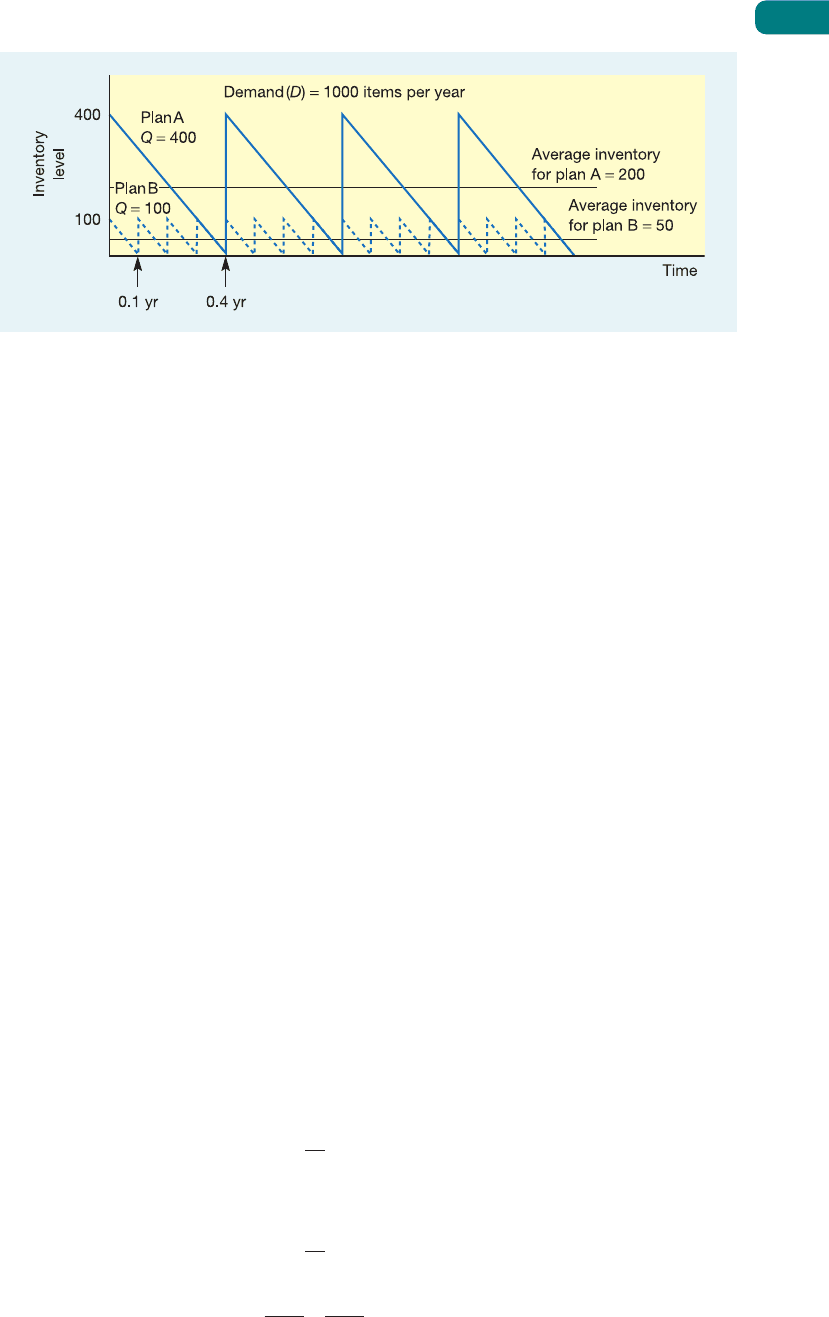
The economic order quantity (EOQ) formula
The most common approach to deciding how much of any particular item to order when
stock needs replenishing is called the economic order quantity (EOQ) approach. This approach
attempts to find the best balance between the advantages and disadvantages of holding stock.
For example, Figure 12.6 shows two alternative order-quantity policies for an item. Plan A,
represented by the unbroken line, involves ordering in quantities of 400 at a time. Demand
in this case is running at 1,000 units per year. Plan B, represented by the dotted line, uses
smaller but more frequent replenishment orders. This time only 100 are ordered at a time,
with orders being placed four times as often. However, the average inventory for plan B is
one-quarter of that for plan A.
To find out whether either of these plans, or some other plan, minimizes the total cost
of stocking the item, we need some further information, namely the total cost of holding one
unit in stock for a period of time (C
h
) and the total costs of placing an order (C
o
). Generally,
holding costs are taken into account by including:
● working capital costs
● storage costs
● obsolescence risk costs.
Order costs are calculated by taking into account:
● cost of placing the order (including transportation of items from suppliers if relevant);
● price discount costs.
In this case the cost of holding stocks is calculated at £1 per item per year and the cost of
placing an order is calculated at £20 per order.
We can now calculate total holding costs and ordering costs for any particular ordering
plan as follows:
Holding costs = holding cost/unit × average inventory
= C
h
×
Ordering costs = ordering cost × number of orders per period
= C
o
×
So, total cost, C
t
=+
C
o
D
Q
C
h
Q
2
D
Q
Q
2
Chapter 12 Inventory planning and control
349
Figure 12.6 Two alternative inventory plans with different order quantities (Q)
Economic order quantity
M12_SLAC0460_06_SE_C12.QXD 10/20/09 9:45 Page 349
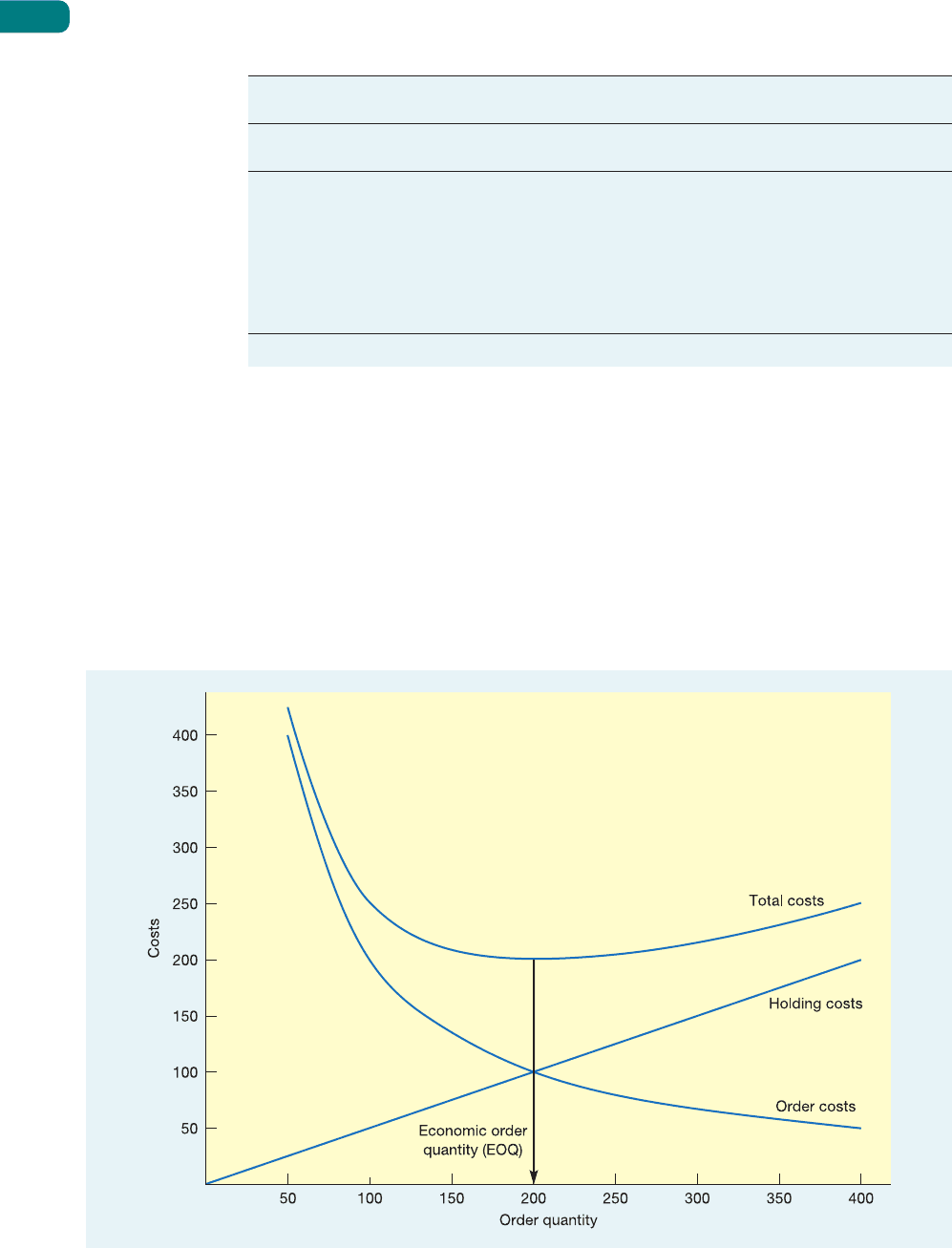
We can now calculate the costs of adopting plans with different order quantities. These are
illustrated in Table 12.1. As we would expect with low values of Q, holding costs are low but
the costs of placing orders are high because orders have to be placed very frequently. As Q
increases, the holding costs increase but the costs of placing orders decrease. Initially the
decrease in ordering costs is greater than the increase in holding costs and the total cost falls.
After a point, however, the decrease in ordering costs slows, whereas the increase in holding
costs remains constant and the total cost starts to increase. In this case the order quantity, Q,
which minimizes the sum of holding and order costs, is 200. This ‘optimum’ order quantity
is called the economic order quantity (EOQ). This is illustrated graphically in Figure 12.7.
Part Three Planning and control
350
Table 12.1 Costs of adoption of plans with different order quantities
Demand (D)
==
1,000 units per year Holding costs (C
h
)
==
£1 per item per year
Order costs (C
o
)
==
£20 per order
Order quantity Holding costs
++
Order costs
==
Total costs
(Q) (0.5Q
××
C
h
) ((D/Q)
××
C
o
)
50 25 20 × 20 = 400 425
100 50 10 × 20 = 200 250
150 75 6.7 × 20 = 134 209
200 100 5 × 20 = 100 200*
250 125 4 × 20 = 80 205
300 150 3.3 × 20 = 66 216
350 175 2.9 × 20 = 58 233
400 200 2.5 × 20 = 50 250
*Minimum total cost.
Figure 12.7 Graphical representation of the economic order quantity
M12_SLAC0460_06_SE_C12.QXD 10/20/09 9:45 Page 350

A more elegant method of finding the EOQ is to derive its general expression. This can be
done using simple differential calculus as follows. From before:
Total cost = holding cost + order cost
C
t
=+
The rate of change of total cost is given by the first differential of C
t
with respect to Q:
=−
The lowest cost will occur when dC
t
/dQ = 0, that is:
0 =−
where Q
o
= the EOQ. Rearranging this expression gives:
Q
o
= EOQ =
When using the EOQ:
Time between orders =
Order frequency = per period
Sensitivity of the EOQ
Examination of the graphical representation of the total cost curve in Figure 12.7 shows
that, although there is a single value of Q which minimizes total costs, any relatively small
deviation from the EOQ will not increase total costs significantly. In other words, costs will
be near-optimum provided a value of Q which is reasonably close to the EOQ is chosen. Put
another way, small errors in estimating either holding costs or order costs will not result in a
significant deviation from the EOQ. This is a particularly convenient phenomenon because,
in practice, both holding and order costs are not easy to estimate accurately.
D
EOQ
EOQ
D
2C
o
D
C
h
C
o
D
Q
o
2
C
h
2
C
o
D
Q
2
C
h
2
dC
t
dQ
C
o
D
Q
C
h
Q
2
Chapter 12 Inventory planning and control
351
A building materials supplier obtains its bagged cement from a single supplier. Demand
is reasonably constant throughout the year, and last year the company sold 2,000 tonnes
of this product. It estimates the costs of placing an order at around £25 each time an
order is placed, and calculates that the annual cost of holding inventory is 20 per cent of
purchase cost. The company purchases the cement at £60 per tonne. How much should
the company order at a time?
EOQ for cement =
=
=
= 91.287 tonnes
100,000
12
2 × 25 × 2,000
0.2 × 60
2C
o
D
C
h
Worked example
➔
M12_SLAC0460_06_SE_C12.QXD 10/20/09 9:45 Page 351
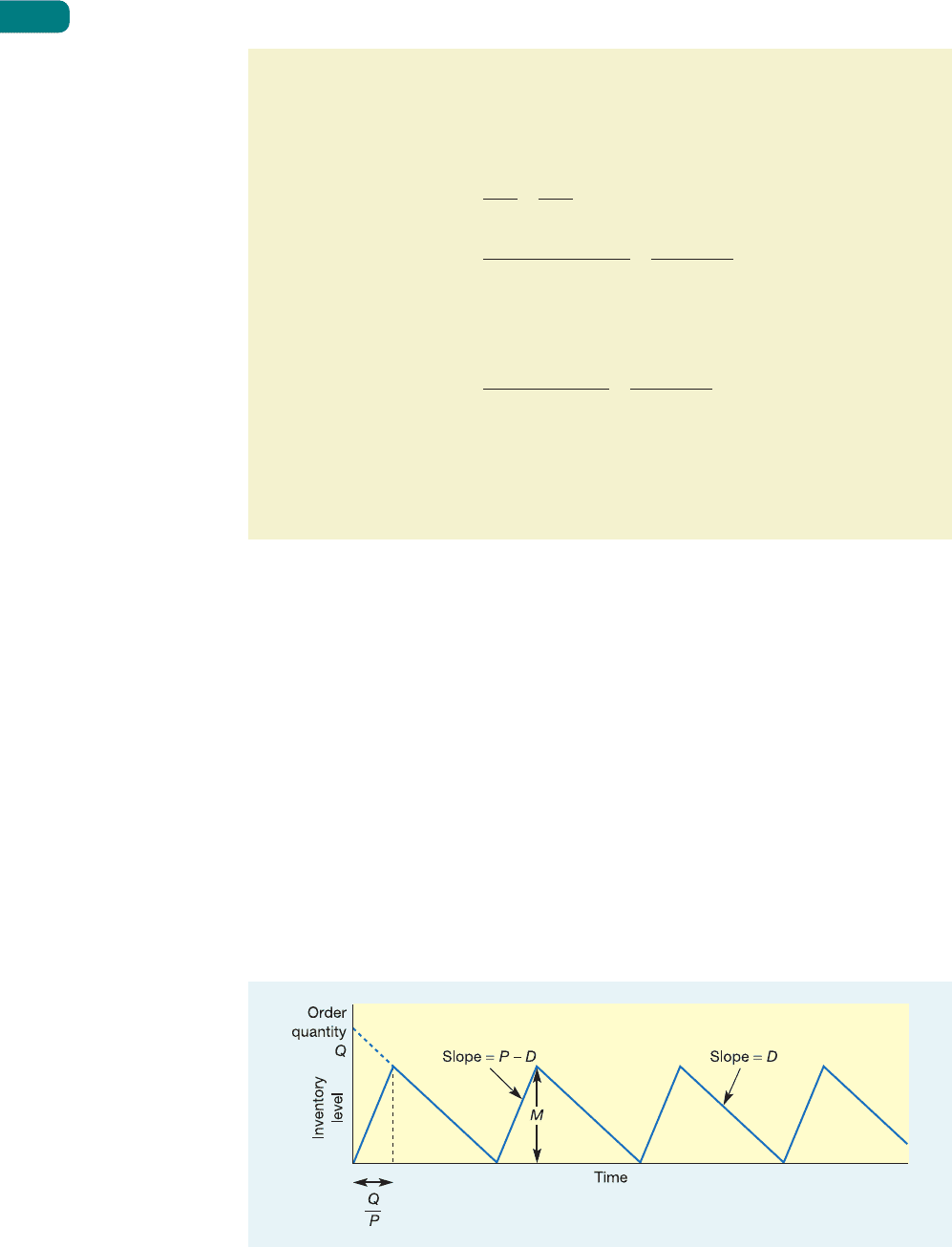
Gradual replacement – the economic batch quantity
(EBQ) model
Although the simple inventory profile shown in Figure 12.5 made some simplifying assump-
tions, it is broadly applicable in most situations where each complete replacement order
arrives at one point in time. In many cases, however, replenishment occurs over a time
period rather than in one lot. A typical example of this is where an internal order is placed
for a batch of parts to be produced on a machine. The machine will start to produce the
parts and ship them in a more or less continuous stream into inventory, but at the same time
demand is continuing to remove parts from the inventory. Provided the rate at which parts
are being made and put into the inventory (P) is higher than the rate at which demand is
depleting the inventory (D), then the size of the inventory will increase. After the batch has
been completed the machine will be reset (to produce some other part), and demand will
continue to deplete the inventory level until production of the next batch begins. The result-
ing profile is shown in Figure 12.8. Such a profile is typical for cycle inventories supplied by
Part Three Planning and control
352
After calculating the EOQ the operations manager feels that placing an order for
91.287 tonnes exactly seems somewhat over-precise. Why not order a convenient
100 tonnes?
Total cost of ordering plan for Q = 91.287:
=+
=+
= £1,095.454
Total cost of ordering plan for Q = 100:
=+
= £1,100
The extra cost of ordering 100 tonnes at a time is £1,100 − £1,095.45 = £4.55. The
operations manager therefore should feel confident in using the more convenient order
quantity.
25 × 2,000
100
(0.2 × 60) × 100
2
25 × 2,000
91.287
(0.2 × 60) × 91.287
2
C
o
D
Q
C
h
Q
2
Figure 12.8 Inventory profile for gradual replacement of inventory
M12_SLAC0460_06_SE_C12.QXD 10/20/09 9:45 Page 352
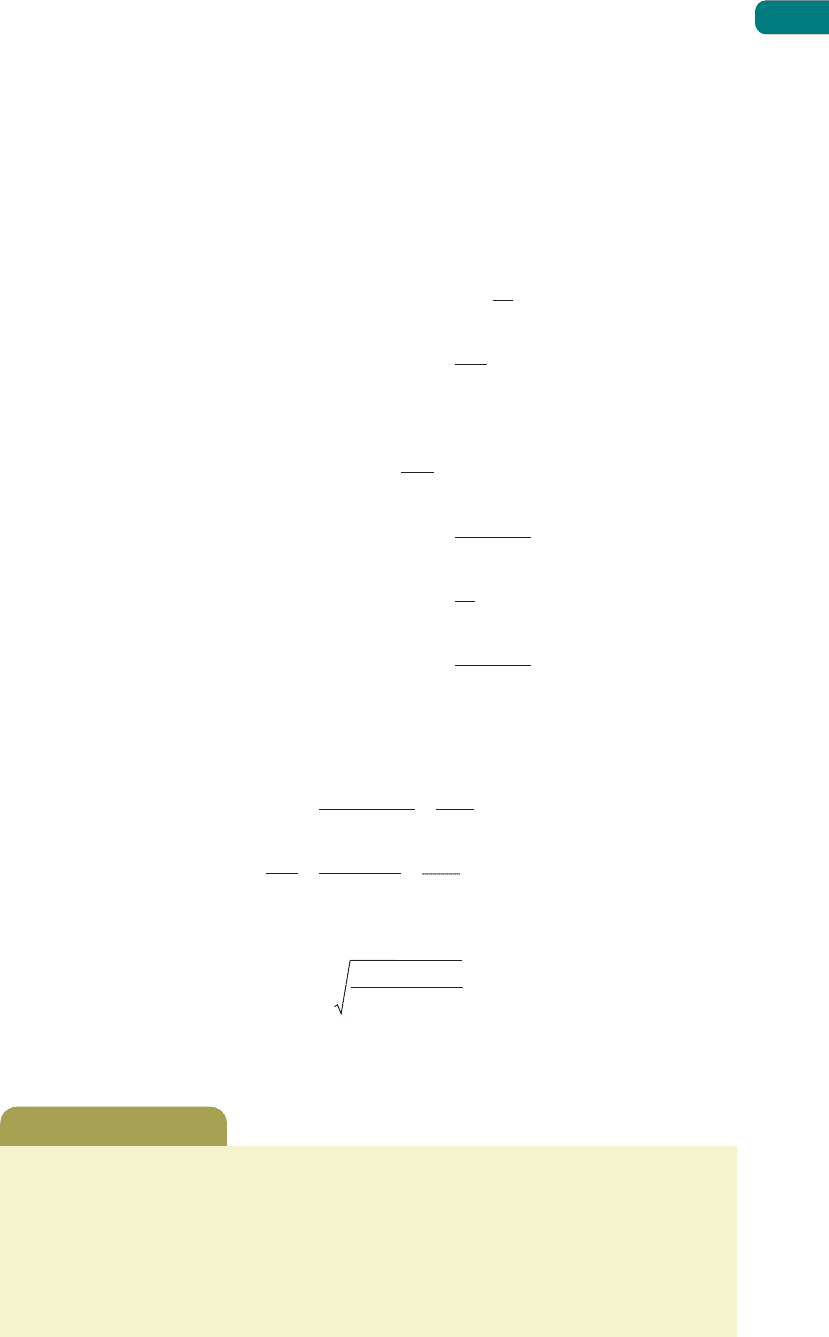
batch processes, where items are produced internally and intermittently. For this reason the
minimum-cost batch quantity for this profile is called the economic batch quantity (EBQ).
It is also sometimes known as the economic manufacturing quantity (EMQ), or the produc-
tion order quantity (POQ). It is derived as follows:
Maximum stock level = M
Slope of inventory build-up = P − D
Also, as is clear from Figure 12.8:
Slope of inventory build-up = M ÷
=
So,
= P − D
M =
Average inventory level =
=
As before:
Total cost = holding cost + order cost
C
t
=+
=−
Again, equating to zero and solving Q gives the minimum-cost order quantity EBQ:
EBQ =
2C
o
D
C
h
(1 − (D/P))
C
o
D
Q
2
C
h
(P − D)
2P
dC
t
dQ
C
o
D
Q
C
h
Q(P − D)
2P
Q(P − D)
2P
M
2
Q(P − D)
P
MP
Q
MP
Q
Q
P
Economic batch quantity
Chapter 12 Inventory planning and control
353
The manager of a bottle-filling plant which bottles soft drinks needs to decide how long
a ‘run’ of each type of drink to process. Demand for each type of drink is reasonably
constant at 80,000 per month (a month has 160 production hours). The bottling lines fill
at a rate of 3,000 bottles per hour, but take an hour to clean and reset between different
drinks. The cost (of labour and lost production capacity) of each of these changeovers
has been calculated at £100 per hour. Stock-holding costs are counted at £0.1 per bottle
per month.
Worked example
➔
M12_SLAC0460_06_SE_C12.QXD 10/20/09 9:45 Page 353
